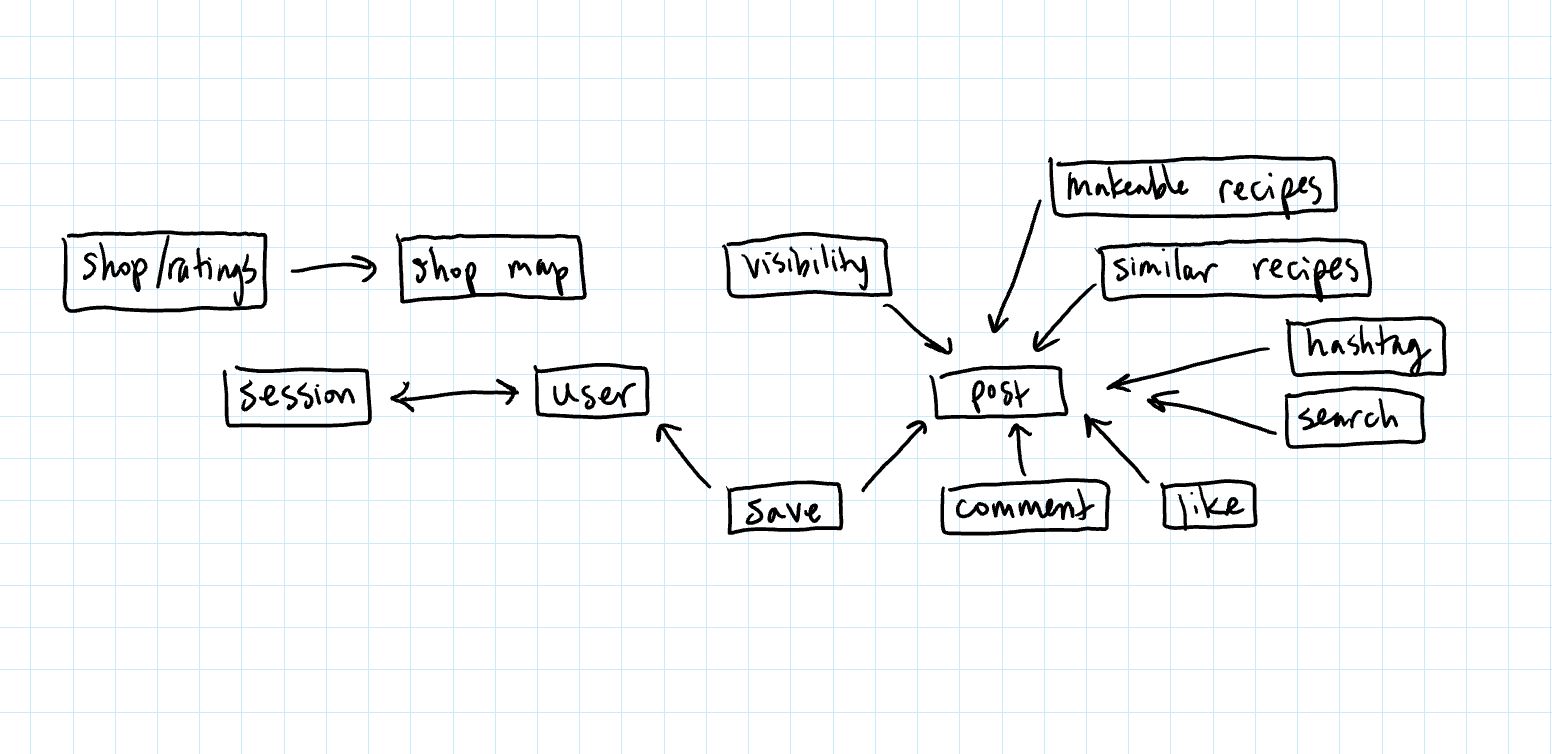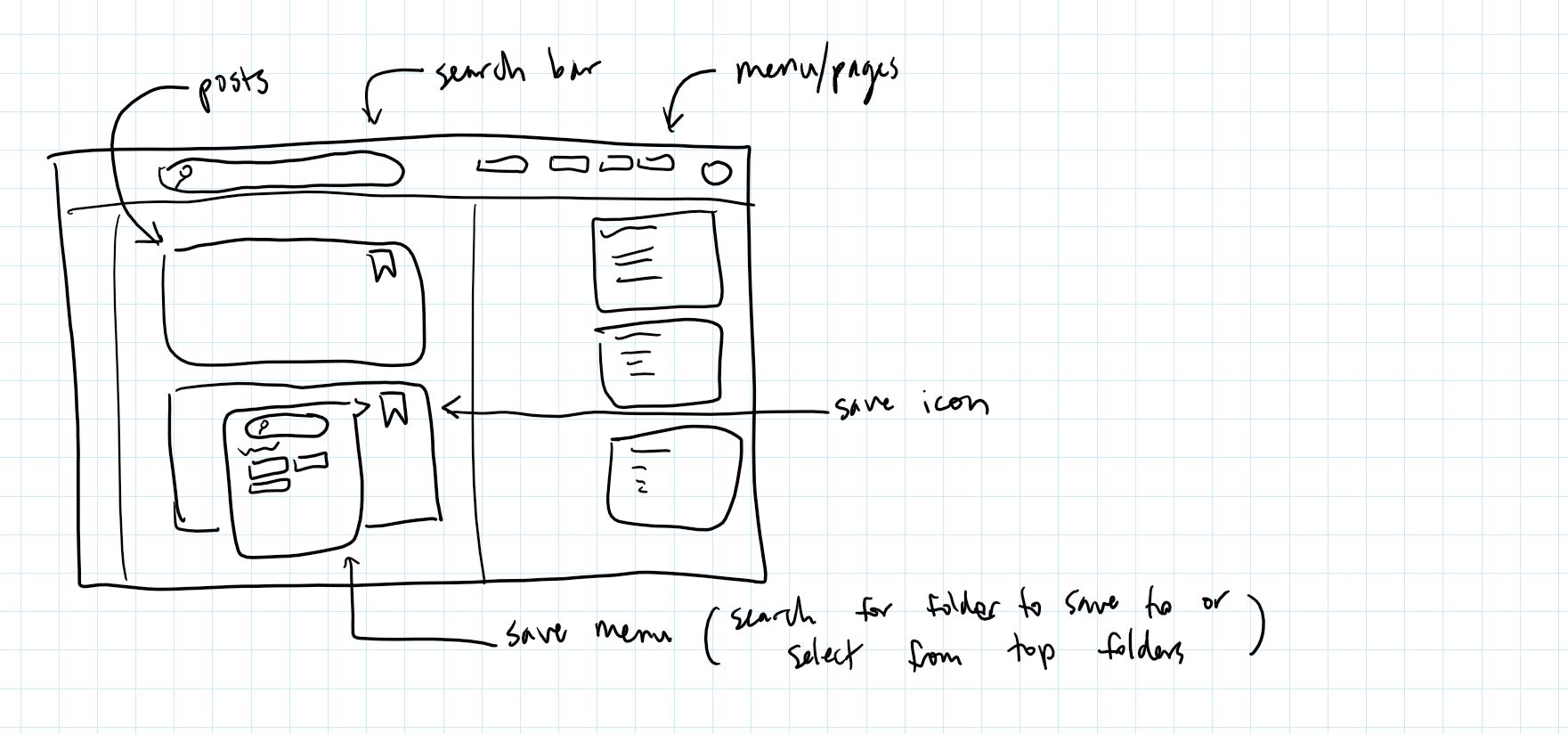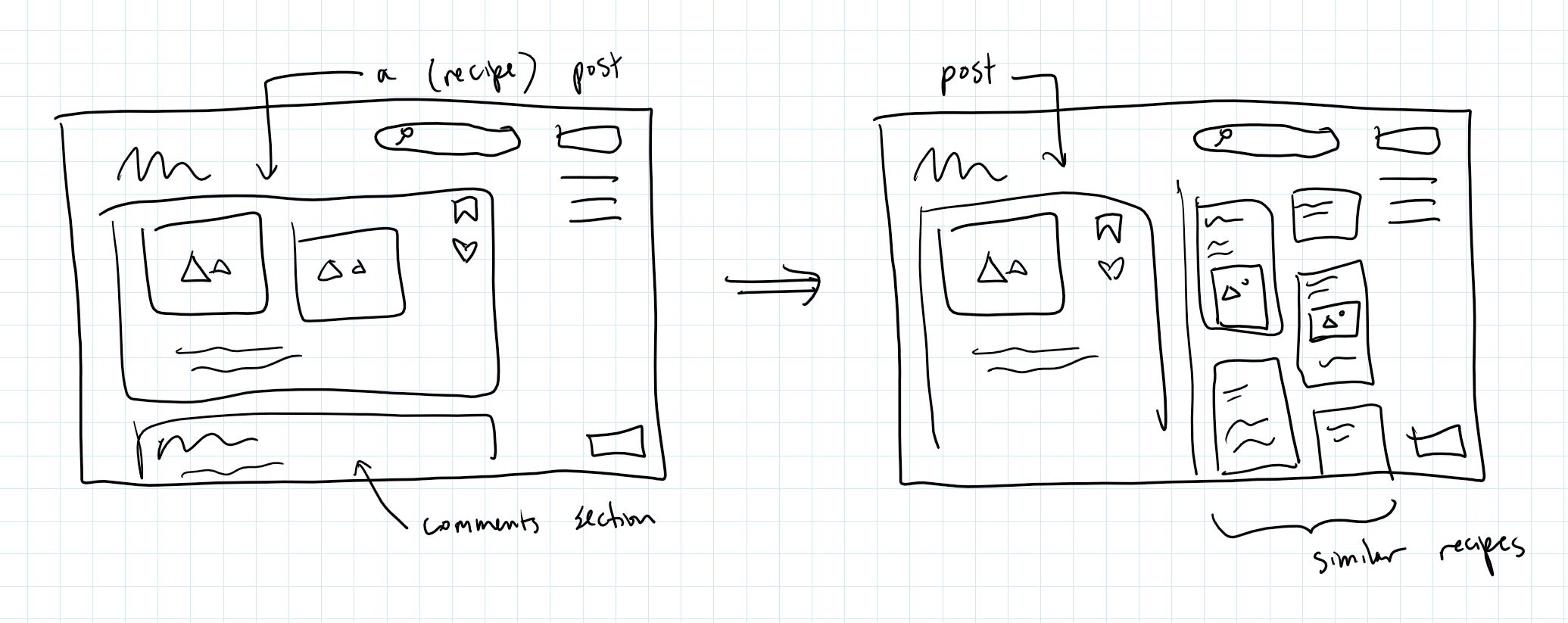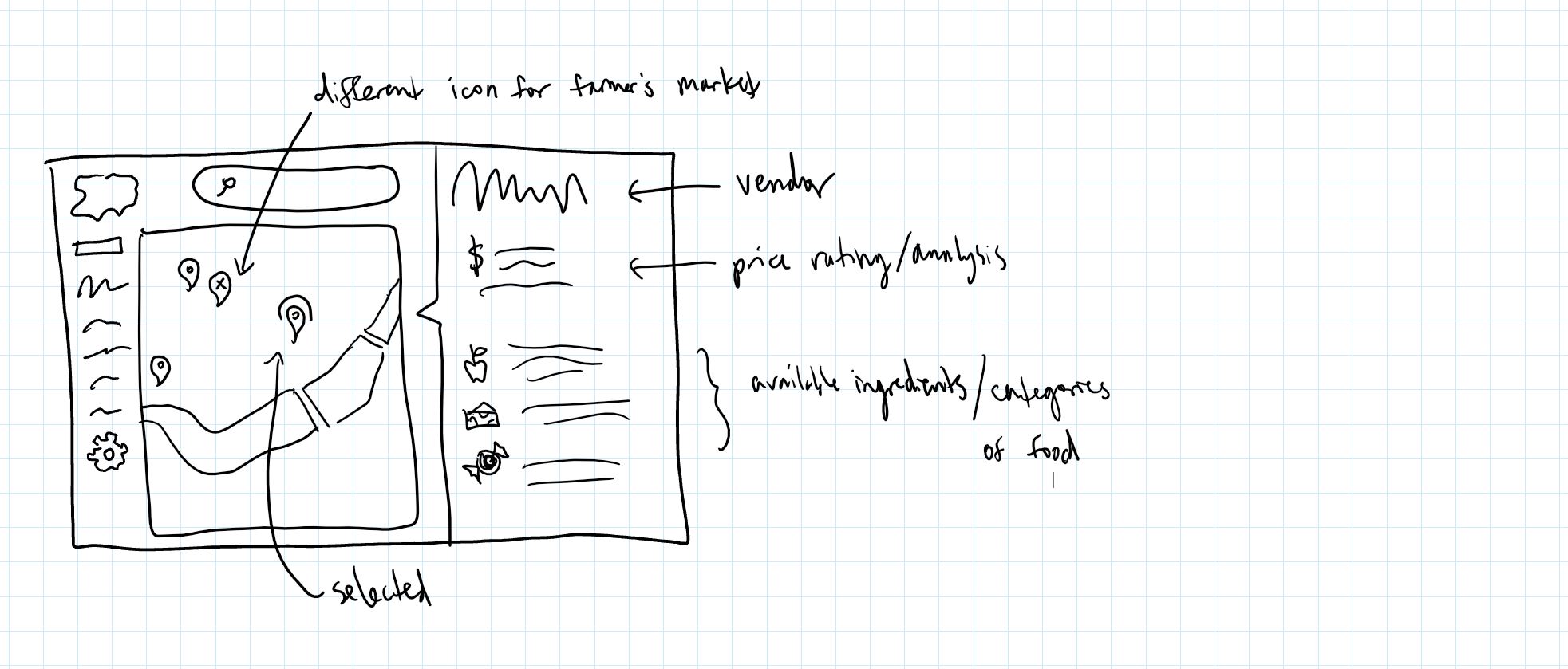Assignment 2
1. Broad Application Goals
Main idea: "Pinterest but more social and for cooking!" This is an app where people can post about their homecooking and share or explore new recipes online. Save and organize recipes in your own customized fashion, whether it's your own creation or something new and delicious you found online!
Name: Cook Nook (possibly subject to change >_<)
Intended Audience: people who are passionate about cooking, seeking advice as new home-cooks, or curious about finding creative recipe ideas!
Value: Currently, there does not seem to be one centralized app where people can find and save cooking recipes; instead, people often surf the internet for ideas and reappropriate other platforms such as Google Docs. This social media platform serves to fit that niche, and in addition to being an easy, personalizable cookbook, it serves as a hub where people can explore new recipes and share their creations with both friends and strangers.
2. Brainstorming Concept Ideas
- User Account: basic account information for each user (i.e. username and password for login)
- User Profile: customizable user info (i.e. personal bio, favorite recipes, favorite posts)
- Like: users can show that they enjoy a post while also increasing the post's popularity
- React: set of icons users can use to react to a post
- Rate: distinct from likes; for recipe-related posts, users can rate the recipe akin to a restaurant review
- Post: method by which users upload or create content
- Supported Media (for posts): types of media supported via posts (i.e. photo, video, text, etc.)
- Custom Post Layouts: pre-formatted templates for ways to layout posts (i.e. combine multiple photos into a single post)
- Comment: users can express thoughts related to an existing post (i.e. offering feedback or suggesting modifications on recipe posts)
- Save: users can save a post to review at a later time
- Custom Save Folders: users can organize their saved posts into custom folders
- Share/Send: users can share a post with friends by sending it to them
- Tag (@ feature): users can tag a friend in a post (i.e. if people bake a recipe together and want to mention the other person)
- Feed: page of public posts that users can scroll through to explore and interact with
- Hashtag: label that users can assign to a post to broadly categorize content
- Filter (by hashtags): filter through posts to find ones that fit the user's desired hashtags
- Search: search through posts by a specific keyword or series of keywords
- Post Notes: users can add notes to existing posts to either re-post them (i.e. share a creative twist on an existing recipe) or save for personal records (i.e. adjustments made on recipes to fit their personal tastes)
- Visibility: users can set visibility of their own posts to private, friends, or public
- Featured Posts: application has some featured posts each day or week, most likely chosen by some algorithm (i.e. holiday recipes for December)
- Recommended Posts: application recommends some content to users based on their liked or saved posts, most likely using some algorithm (i.e. someone who loves to bake gets baking recipes, ice cream recipes being recommended during the summer)
- Daily Content: some daily content of interest for users (i.e. fun food fact, a recipe suggestion, etc.)
- Makeable Recipes: given a set of ingredients, the application suggests a series of recipes that can be made using those ingredients (and basic pantry ingredients)
- Similar Recipes: given a recipe, the application suggests a series of recipes making the same dish or a similar dish, which may be useful as reference for creating a new recipe that combines elements of the suggested recipes
3. VSD Analysis
Prompt 1 - Stakeholders, Variations in Abilities
Observation: Visually-impaired users cannot read comments or recipes from posts.
Design Response: The application could support screen-readers or have its own built-in text reader. Having a built-in reader with adjustable settings (i.e. word commands, reading speed, etc.) could also be convenient for all users, since they can listen and follow along to recipes from the app while cooking instead of constantly needing to come back to read the instructions.
Prompt 2 - Stakeholders, Indirect Stakeholders
Observation: One concern could be that this social cooking app overlaps with the audience of food bloggers. Moreover, it would be very easy for app users to plagiarize existing recipes from food bloggers or websites and post them online as their own.
Design Response: One option could be to use existing frameworks for checking plagiarism and not allow users to post content that does not pass the plagiarism check. However, this seems very impractical for a cooking-oriented application, since many recipes will have similar ingredients or similarly-phrased instructions (i.e. "preheat oven to X degrees"). In terms of values, copying recipes may or may not be a matter of concern to some people. On the one hand, many people believe recipes should be shared. On the other hand, coming up with recipes takes a nontrivial amount of experimentation, effort, and creativity, and these should be credited to the original creator. To perhaps balance these two perspectives, the application could be framed in a manner that makes crediting original recipe-creators or referenced inspiration as easy as possible. For example, in the UI for creating a post, there could be a section titled "References," where users could link recipes or photos that inspired their current post. This is not a solution that completely prevents plagiarism, but it will help demonstrate the values of the application and hopefully portray both sharing ideas and giving credit to others as a positive thing.
Prompt 3 - Time, Reappropriation
Observation: As with many social media platforms, the nature of sharing content makes it possible that the application be reappropriated to share harmful or inappropriate content. Similarly, the platform could also be used for cyberbullying.
Design Response: One approach could be content moderation. This could come in the form of user moderators simlar to those on Reddit, hired employees, or a given algorithm. Alternatively, the role of moderator could be given implicitly rather than explicitly to users in the sense that users can report content that they find inappropriate or harmful. Of these options, having users report content and some type of human or algorithm behind the scenes approve or deny those reports would most likely be the best course of action. Users will automatically get a say in what type of content they would like to see on the platform, but content will also be moderated on a larger scale so that users cannot randomly report any content they do not like for whatever reason. On the subject of content moderation itself, there is a strong argument to be made that people should be allowed freedom of speech, and it can be extremely difficult to agree on what content is considered inappropriate. However, this application is primarily intended to serve a niche in cooking, and there are other more generalized social media apps in existence, so I do not believe there will be particularly strong societal implications based on where this application draws the line of inappropriate content. Personally, for this application, I would ban content that is explicitly inappropriate or criminal. For reports on mean-spirited posts or bullying, I would consider having the app issue a warning to the poster, but for the most part, self-moderation within the app in the form of likes/dislikes and a feature for blocking certain users would probably be sufficient.
Prompt 4 - Pervasiveness, Widespread Use
Observation: Given that this application is cooking- and recipe-focused, there is the possibility that it might change expectations around food and cooking. There might be a shift to make home cooking more procedural, where people are always following recipes and there is less freeform cooking. On the other hand, recipe creators may become very popular, and people who simply follow recipes without creativity might be ridiculed. Lastly and most importantly, heavy discourse around food and eating habits may lead to hyperfixation on diet (as seen already in food trends and challenges on other media platforms), and it may become the norm to know exactly what you, your friends, and your co-workers are eating on a day-to-day basis. On the one hand, this can be inspiring, but on the other hand, people may feel more exposed and insecure about their dietary choices, and users may be bullied for making extremely healthy or extremely unhealthy choices.
Design Response: Given the unpredictable nature of the observation and the fact that these effects are somewhat inseparable from the idea of sharing food-related experiences, some of these problems are probably unavoidable without severe content moderation. However, a large part of application design is to set the tone of the application and user space. In this sense, marketing the app as being more recipe-oriented (as opposed to diet-oriented) may be a good starting point. In addition, reminders to be kind and focus on exploring food rather than fixating on minute dietary choices can be incorporated into the application in a positive way. For example, the Taiwan subway system has many cute signs to remind passengers to give up seats to pregnant women and the elderly, and while these are not strictly enforced in practice, the signs and implicit social contract make it so that most people will give up seats when the opportunity arises. A similar effect can be created in the space of this food and cooking app via the default hashtags available, the type of content shown on the recommended and featured post feeds, and even something as small as the color scheme or artistic design of the application (i.e. pastel colors might be more soothing and remind people of the comfort of a home kitchen).
Prompt 5 - Pervasiveness, Crossing National Boundaries
Observation: If the application reaches a point where it crosses national or cultural boundaries, there may be concerns regarding how to make posts and recipes accessible to all users. Language is a common concern, but with cooking specifically, one might also need to consider the different measuring systems, accessibility of particular ingredients, and cultural gaps related to food (i.e. some countries eat chicken feet, dog meat, snails, etc.)
Design Response: To address these cases, it would be very beneficial to add some extra features to the cooking application. For example, there could be a built-in tool for converting between measuring systems. Ideally, this could be applied to automatically generate a new recipe in the correct measuring system, but a side-bar tool that supports manual inputs to convert between systems would also work. For language, the recipe could support Google Translate but with some specific adjustments to increase accuracy for food-related terminology. For accessibility of ingredients, the application could leverage the featured posts feature to pin posts with tips on how to subsititute or find tricky ingredients. For cultural gaps related to food, the featured posts page could be used again to feature recipes that highlight particular cultural differences and provide insightful context.
4. Identifying Concepts
Concept 1
Name: Post
Purpose: Upload content to the platform
Operational Principle: Users can create and publish posts containing media such as text, image, video, etc.
Concept 2
Name: Like
Purpose: Send positive feedback to author
Operational Principle: When a user likes a post, it is made visible to the author (often via aggregated notifications)
Concept 3
Name: Comment
Purpose: Discuss content or send more detailed feedback to author
Operational Principle: Users can write a response (often containing text, images or video) to a post and publish it, and the author is notified
Concept 4
Name: Save
Purpose: Save content for future reference
Operational Principle: When a user saves a post, a link to the post is added to some easily accessible page that the user can refer back to later
Concept 5
Name: Search
Purpose: Search for content related to a particular topic or idea
Operational Principle: When a user searches a keyword or string of keywords, posts related to the search criteria appear; users can search choose to search out of all public posts, all posts made by friends, all of their own posts, or all posts they have saved
Concept 6
Name: Hashtag
Purpose: Categorize posts into topics of interest
Operational Principle: When a user sees a post hashtag, they can see what the general post is about without having to read the entire post
Concept 7
Name: Visibility
Purpose: Control who can see a post
Operational Principle: Users can set the visibility of each of their individual posts to public, friends, or private, where public means the post is visible to everyone, and private means it is visible to no one.
Concept 8
Name: Makeable Recipes
Purpose: Find potential recipes based on available ingredients
Operational Principle: User inputs key ingredients that they have on hand, and the application recommends recipes that use the available ingredients
Concept 9
Name: Similar Recipes
Purpose: Given a recipe or post, find similar recipes or posts
Operational Principle: User selects a post containing a recipe, and the application recommends recipe posts that re-create the same dish; this is often useful when making a new dish, since looking at other recipes gives a better sense of what ingredients could be incorporated and the variation of key ingredient ratios
Concept 10
Name: Shop Map
Purpose: Find and compare nearby stores, supermarkets and farmers' markets
Operational Principle: Input is a location and possibly a genre of ingredients a user is looking for (i.e. meat, fish, produce, pantry), and the application shows a map of local vendors as well as various ratings for each vendor (i.e. variety rating, quality rating, average price rating--relatively cheap or expensive?)
5. Dependence Diagram

6. Sketching Concept UIs
Concept - Save

Concept - Similar Recipes

Concept - Shop Map
